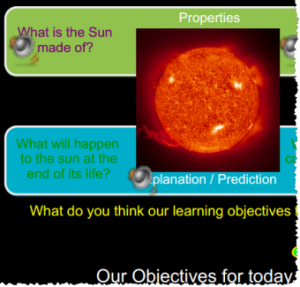Gas laws: Difference between revisions
mNo edit summary |
m (subjects, ages, types) |
||
| (One intermediate revision by the same user not shown) | |||
| Line 2: | Line 2: | ||
[[Category:Science]] | [[Category:Science]] | ||
{{Rinfo | {{Rinfo | ||
|type= Lesson idea | |||
|attribution={{Chris Tooley}} | |||
|final= | |final= | ||
|title=Gas laws | |title=Gas laws | ||
Latest revision as of 14:41, 28 September 2012
Astronomy - presentations
[[|<<<]]
[[|>>>]]
This resource may not be final.
Lesson idea. This lesson is part of a series looking at astronomy and the nature of stars. Students have already seen how the distance of stars is calculated and how their chemistry can be ascertained from spectral emissions. In this slide presentation, we diverge and look at the gas laws. Students may believe that the temperature of gases is a mysterious energy rather than the notion of moving particles. As well as a file for presentation, the teacher includes an audio file explaining what the slides show.
Teaching approach. The lesson model is that of active note-making. Students must not take notes from the board but instead must use their creativity to develop their own notes. They are encouraged to use colour, image, symbols, humour and metaphor to lead them through a richer learning experience. Students need help in achieving this but soon catch onto the idea. They become more independent with taking notes and more attentive to the subject at hand. The teacher keeps a clear focus to use open rather than closed questioning throughout. (edit)
| Resource details | |
| Title | Gas laws |
| Topic | |
| Teaching approach | |
| Learning Objectives |
|
| Format / structure | |
| Subject | |
| Age of students / grade | |
| Table of contents | |
| Additional Resources/material needed | |
| Useful information | |
| Related ORBIT Wiki Resources | |
| Other (e.g. time frame) | |
| Files and resources to view and download |
The presentation has been converted to alternative formats:
|
| Acknowledgement | |
| License | |

